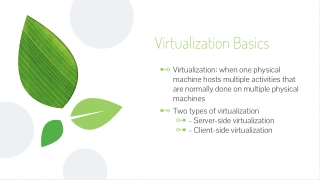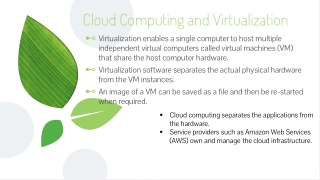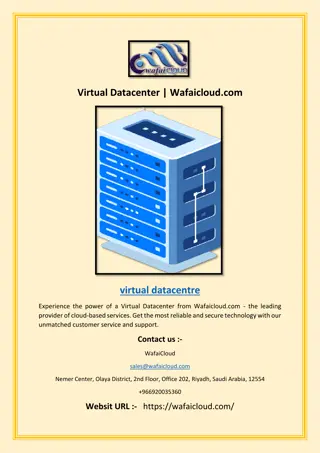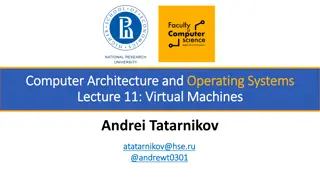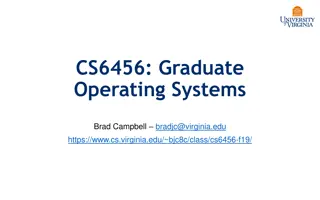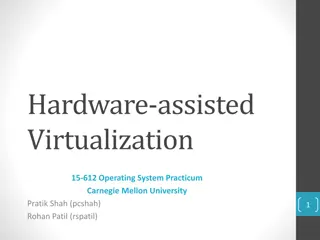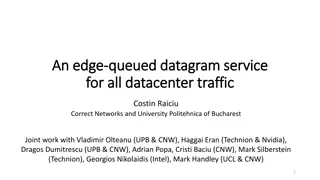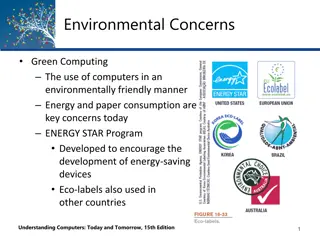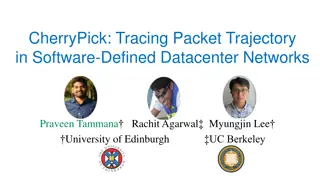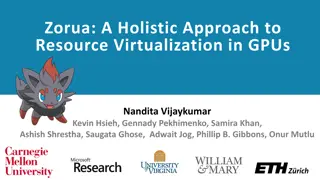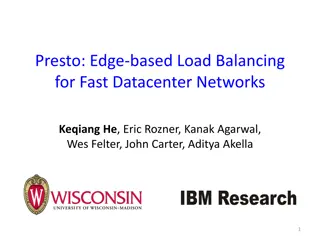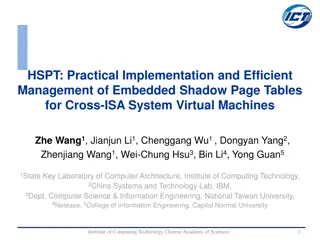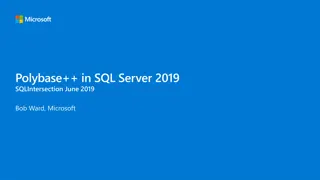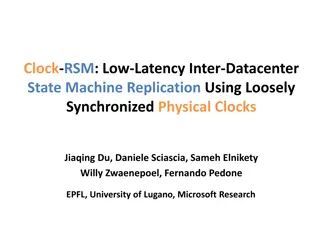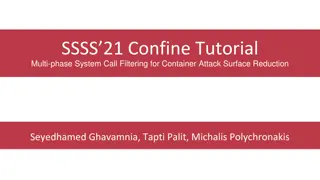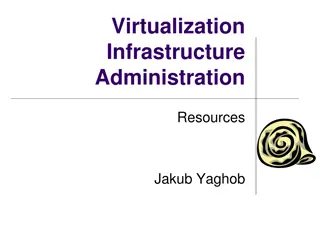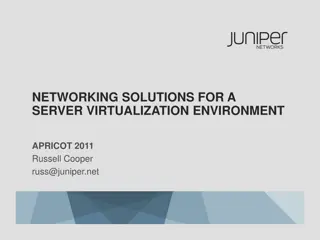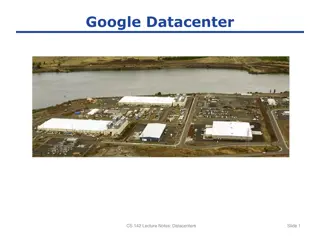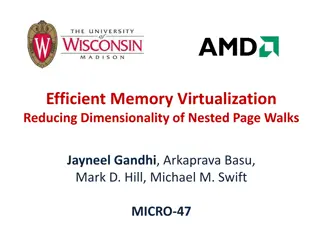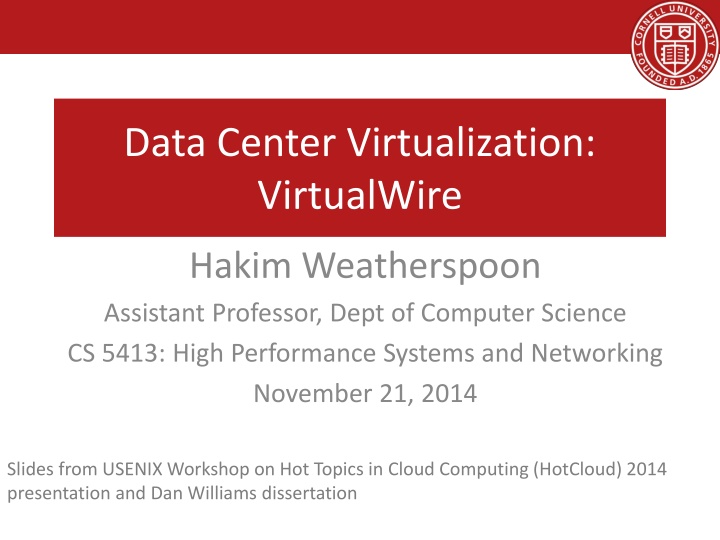
Virtual Network Abstraction and Control Logic in Cloud Computing
Explore the concept of VirtualWire in cloud computing, enabling user control over network components and policies. Learn how moving control logic to users can enhance network management efficiency and flexibility across cloud environments.
Download Presentation

Please find below an Image/Link to download the presentation.
The content on the website is provided AS IS for your information and personal use only. It may not be sold, licensed, or shared on other websites without obtaining consent from the author. If you encounter any issues during the download, it is possible that the publisher has removed the file from their server.
You are allowed to download the files provided on this website for personal or commercial use, subject to the condition that they are used lawfully. All files are the property of their respective owners.
The content on the website is provided AS IS for your information and personal use only. It may not be sold, licensed, or shared on other websites without obtaining consent from the author.
E N D
Presentation Transcript
Data Center Virtualization: VirtualWire Hakim Weatherspoon Assistant Professor, Dept of Computer Science CS 5413: High Performance Systems and Networking November 21, 2014 Slides from USENIX Workshop on Hot Topics in Cloud Computing (HotCloud) 2014 presentation and Dan Williams dissertation
Goals for Today VirtualWires for Live Migrating Virtual Networks across Clouds D. Williams, H. Jamjoom, Z. Jiang, and H. Weatherspoon. IBM Tech. Rep. RC25378, April 2013.
Control of cloud networks Cloud interoperability User control of cloud networks Enterprise Workloads VM VM VM VM VM VM Efficient Cloud Resource Utilization (Overdriver) User Control of Cloud Networks (VirtualWire) Supercloud Cloud Interoperability (The Xen-Blanket) Third-Party Clouds 4
current clouds lack control over network Cloud networks are provider-centric Control logic that encodes flow policies is implemented by provider Provider decides if low-level network features (e.g., VLANs, IP addresses, etc.) are supported What virtual network abstraction should a cloud provider expose? Management Tools CLOUD USER Use APIs to specify addressing, access control, flow policies, etc VM VM CLOUD PROVIDER Control Logic (virtual switches, routers, etc) Virtual Network support rich network features 5
virtualwire Key Insight: move control logic to user Virtualized equivalents of network components Open vswitch, Cisco Nexus 1000V, NetSim, Click router, etc. Management Tools CLOUD USER Configure using native interfaces Use APIs to specify peerings Control Logic (virtual switches, routers, etc) VM VM Provider just needs to enable connectivity Connect/disconnect CLOUD PROVIDER Virtual Network VirtualWire connectors Point-to-point layer-2 tunnels support location independent tunnels 6
Outline Motivation VirtualWire Design Implementation Evaluation Conclusion
VirtualWire connectors / wires Point-to-point layer-2 network tunnels VXLAN wire format for packet encapsulation Endpoints migrated with virtual network components Implemented in the kernel for efficiency 8
VirtualWire connectors / wires Connections between endpoints E.g. tunnel, VPN, local bridge Each hypervisor contains endpoint controller Advertises endpoints Looks up endpoints Sets wire type Integrates with VM migration Simple interface connect/disconnect
VirtualWire connectors / wires Types of wires Native (bridge) Encapsulating (in kernel module) Tunneling (Open-VPN based) /proc interface for configuring wires Integrated with live migration
Connector Implementation Connectors are layer-2-in-layer-3 tunnels 44 byte UDP header includes 32-bit connector ID Outer Ethernet Header Outer IP IHL TOS Total Length Version Identification Fragment Offset Flags Time to Live Protocol Header Checksum Outer Source Address Outer Destination Address Outer UDP Source Port Dest Port UDP Length UDP Checksum VirtualWire Connector ID Inner Ethernet Inner Destination MAC Address Inner Destination MAC Address Inner Source MAC Address Inner Source MAC Address Optional Ethertype = C-Tag [802.1Q] Inner.VLAN Tag Information Original Ethernet Payload
virtualwire and the xen-blanket Blanket layer provides hypervisor level features through nested virtualization on Xen-Blanket (nested) Network Component USER OWNED third-party clouds VirtualWire Xen-Blanket (non-nested) Xen/Dom 0 Endpoint Manager Network Component VirtualWire Xen/Dom 0 Endpoint Manager Third-party cloud (RackSpace, EC2, etc.) HARDWARE HARDWARE Enables cross-provider live migration 12
Implementation Dom U Dom U Dom U Network Component (Switch) Server Server Front Front Front Front Endpoint Back Back Endpoint Endpoint Back Endpoint Back Bridge Bridge Bridge Bridge Dom 0 Dom 0 Dom 0 Outgoing Interface Outgoing Interface Outgoing Interface
Implementation Xen-Blanket 3 Xen-Blanket 1 Xen-Blanket 2 Dom U Dom U Dom U Network Component Server Server vSwitch Front eth0 Front eth0 Front eth0 Front eth1 USER OWNED Back vif1.0 Endpoint vwe1.0 Back vif1.0 Endpoint vwe1.0 Back vif1.1 Endpoint vwe1.1 Back vif1.0 Endpoint vwe1.0 Bridge br1.0 Bridge br1.0 Bridge br1.0 Bridge br1.1 Front eth0 Front eth0 Front eth0 Dom 0 Dom 0 Dom 0 Dom 0 Dom 0 Back vif1.0 Back vif2.0 Back vif1.0 THIRD-PARTY xenbr0 xenbr0 CLOUD Outgoing Interface eth0 Outgoing Interface eth0 PHYSICAL MACHINE 2 PHYSICAL MACHINE 1
Optimizations Xen-Blanket 1 Xen-Blanket 2 Xen-Blanket 3 Dom U Dom U Server Server Front Front vSwitch Endpoint Back Endpoint Back Endpoint Endpoint Bridge Bridge Outgoing Interface Outgoing Interface Outgoing Interface Dom 0 Dom 0 Dom 0
Optimizations Xen-Blanket 2 Xen-Blanket 1 Dom U Dom U Dom U vSwitch Server Server Front Front Front Front Back Back Endpoint Back Endpoint Back Bridge Bridge Endpoint Bridge Outgoing Interface Outgoing Interface Dom 0 Dom 0
Optimizations Xen-Blanket 1 Dom U Dom U Server Server Front Front vSwitch Back Back Back Back Loop Loop Endpoint Bridge Endpoint Bridge Dom 0
Outline Motivation VirtualWire Design Implementation Evaluation Conclusion
cross provider live migration all orange interfaces are on the same layer 2 virtual segment (attached to the same bridge) that spans both clouds, connected through an SSH tunnel. Dom U Dom U Dom 0 Gateway Server DNS, DHCP, NFS VM VM.img SSH Dom U Dom 0 FW Xen-Blanket VM Our Cloud SSH both domain 0s can access the NFS share through the virtual network. Xen-Blanket EC2 19
Amazon EC2 and local resources EC2 (4XL): 33 ECUs, 23 GB memory, 10 Gbps Ethernet Local: 12 cores @ 2.93 GHz, 24 GB memory, 1Gbps Ethernet Xen-blanket for nested virtualization Dom 0: 8 vCPUs, 4 GB memory PV guests: 4 vCPUs, 8 GB memory Local NFS server for VM disk images netperf to measure throughput latency 1400 byte packets
cross-provider live migration Migrated 2 VMs and a virtual switch between Cornell and EC2 No network reconfiguration Downtime as low as 1.4 seconds 21
Outline Motivation VirtualWire Design Implementation Evaluation Conclusion
performance issues Virtual network components can be bottlenecks physical interface limitations Several approaches Co-location Distributed components Evolve virtual network 23
Before Next time Project Interim report Due Monday, November 24. And meet with groups, TA, and professor Fractus Upgrade: Should be back online Required review and reading for Monday, November 24 Making Middleboxes Someone Else s Problem: Network Processing as a Cloud Service, Making middleboxes someone else's problem: network processing as a cloud service, J. Sherry, S. Hasan, C. Scott, A. Krishnamurthy, S. Ratnasamy, and V. Sekar. ACM SIGCOMM Computer Communication Review (CCR) Volume 42, Issue 4 (August 2012), pages 13-24. http://dl.acm.org/citation.cfm?id=2377680 http://conferences.sigcomm.org/sigcomm/2012/paper/sigcomm/p13.pdf Check piazza: http://piazza.com/cornell/fall2014/cs5413 Check website for updated schedule
Decoupling gives Flexibility Cloud s flexibility comes from decoupling device functionality from physical devices Aka virtualization Can place VM anywhere Consolidation Instantiation Migration Placement Optimizations
Are all Devices Decoupled Today: Split driver model Guests don t need device specific driver System portion interfaces with physical devices Dependencies on hardware Presence of device (e.g. GPU, FPGA) Device-related configuration (e.g. VLAN) Ring 3 Dom 0 Dom U: Guest KernelUser Ring 1 Physical Device Driver Backend Driver Frontend Driver Ring 0 Xen Hardware
Devices Limit Flexibility Today: Split driver model Dependencies break if VM moves No easy place to plug into hardware driver System portion connected in ad-hoc way Ring 0 Ring 3 Dom 0 Dom U: Guest VM KernelUser Ring 1 Physical Device Driver Backend Driver Frontend Driver . Xen Hardware
Split driver again! Clean separation between hardware driver and backend driver Standard interface between endpoints Ring 3 Dom 0 Dom U: Guest VM KernelUser Ring 1 Physical Device Driver Backend Driver Frontend Driver Connected with wires Ring 0 . Xen Hardware

